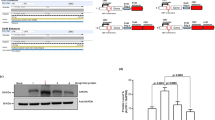Abstract
In an effort to make a fast and convenient approach for efficient production of recombinant antibody, transient gene expression was performed in human embryonic kidney 293E (HEK293E) cells, which have been widely used as a mammalian host for transient expression of recombinant proteins. Woodchuck hepatitis virus post-transcriptional regulation element (WPRE) was employed to increase the antibody production. Under the influence of WPRE, the antibody production was increased by 5.5-fold through the enhancement of total mRNA levels of HC and LC, and the efficient export of nuclear mRNA into the cytoplasm. Using WPRE, 1.9 mg of cumulative recombinant antibody was obtained in transiently transfected adherent HEK293E cells from one 100 mm dish transfection with 10 mL medium exchange every 3 days for 24 days of cultivation. In addition, the highest recombinant antibody concentration of 81 mg/L was obtained. This simple and efficient approach of antibody production is expected to provide a sufficient amount of antibody for screening experiments.
Similar content being viewed by others
References
Wang, W., S. Singh, D. L. Zeng, K. King, and S. Nema (2007) Antibody structure, instability, and formulation. J. Pharm. Sci. 96: 1–26.
Lee, J. C., D. Y. Kim, D. J. Oh, and H. N. Chang (2008) Two-stage depth filter perfusion culture for recombinant antibody production by recombinant Chinese hamster ovary cell. Biotechnol. Bioprocess Eng. 13: 560–565.
Kim, M. S., W. H. Kim, and G. M. Lee (2008) Characterization of site-specific recombination mediated by Cre recombinase during the development of erythropoietin producing CHO cell lines. Biotechnol. Bioprocess Eng. 13: 418–423.
Baldi, L., D. L. Hacker, M. Adam, and F. M. Wurm (2007) Recombinant protein production by large-scale transient gene expression in mammalian cells: state of the art and future perspectives. Biotechnol. Lett. 29: 677–684.
Wurm, F. and A. Bernard (1999) Large-scale transient expression in mammalian cells for recombinant protein production. Curr. Opin. Biotechnol. 10: 156–159.
Yates, J. L., N. Warren, and B. Sugden (1985) Stable replication of plasmids derived from Epstein-Barr virus in various mammalian cells. Nature 313: 812–815.
Ambinder, R. F., M. A. Mullen, Y. N. Chang, G. S. Hayward, and S. D. Hayward (1991) Functional domains of Epstein-Barr virus nuclear antigen EBNA-1. J. Virol. 65: 1466–1478.
Langle-Rouault, F., V. Patzel, A. Benavente, M. Taillez, N. Silvestre, A. Bompard, G. Sczakiel, E. Jacobs, and K. Rittner (1998) Up to 100-fold increase of apparent gene expression in the presence of Epstein-Barr virus oriP sequences and EBNA1: implications of the nuclear import of plasmids. J. Virol. 72: 6181–6185.
Reisman, D. and B. Sugden (1986) Trans activation of an Epstein-Barr viral transcriptional enhancer by the Epstein-Barr viral nuclear antigen 1. Mol. Cell. Biol. 6: 3838–3846.
Donello, J. E., J. E. Loeb, and T. J. Hope (1998) Woodchuck hepatitis virus contains a tripartite posttranscriptional regulatory element. J. Virol. 72: 5085–5092.
Schambach, A., H. Wodrich, M. Hildinger, J. Bohne, H. G. Krausslich, and C. Baum (2000) Context dependence of different modules for posttranscriptional enhancement of gene expression from retroviral vectors. Mol. Ther. 2: 435–445.
Rosser, M. P., W. Xia, S. Hartsell, M. McCaman, Y. Zhu, S. Wang, S. Harvey, P. Bringmann, and R. R. Cobb (2005) Transient transfection of CHO-K1-S using serumfree medium in suspension: a rapid mammalian protein expression system. Protein Expr. Purif. 40: 237–243.
Kreppel, F. and S. Kochanek (2004) Long-term transgene expression in proliferating cells mediated by episomally maintained high-capacity adenovirus vectors. J. Virol. 78: 9–22.
Shan, L., L. Wang, J. Yin, P. Zhong, and J. Zhong (2006) An OriP/EBNA-1-based baculovirus vector with prolonged and enhanced transgene expression. J. Gene Med. 8: 1400–1406.
Wulhfard, S., S. Tissot, S. Bouchet, J. Cevey, M. De Jesus, D. L. Hacker, and F. M. Wurm (2008) Mild hypothermia improves transient gene expression yields several fold in Chinese hamster ovary cells. Biotechnol. Prog. 24: 458–465.
Kim, S. J., M. H. Jang, J. T. Stapleton, S. O. Yoon, K. S. Kim, E. S. Jeon, and H. J. Hong (2004) Neutralizing human monoclonal antibodies to hepatitis A virus recovered by phage display. Virology 318: 598–607.
Wang, Y., W. Zhu, and D. E. Levy (2006) Nuclear and cytoplasmic mRNA quantification by SYBR green based real-time RT-PCR. Methods 39: 356–362.
Kim, N. S. and G. M. Lee (2002) Response of recombinant Chinese hamster ovary cells to hyperosmotic pressure: effect of Bcl-2 overexpression. J. Biotechnol. 95: 237–248.
Klein, R., B. Ruttkowski, E. Knapp, B. Salmons, W. H. Gunzburg, and C. Hohenadl (2006) WPRE-mediated enhancement of gene expression is promoter and cell line specific. Gene 372: 153–161.
Leitzgen, K., M. R. Knittler, and I. G. Haas (1997) Assembly of immunoglobulin light chains as a prerequisite for secretion. A model for oligomerization-dependent subunit folding. J. Biol. Chem. 272: 3117–3123.
Schlatter, S., S. H. Stansfield, D. M. Dinnis, A. J. Racher, J. R. Birch, and D. C. James (2005) On the optimal ratio of heavy to light chain genes for efficient recombinant antibody production by CHO cells. Biotechnol. Prog. 21: 122–133.
Author information
Authors and Affiliations
Corresponding author
Additional information
The first two authors equally contributed to this work
Rights and permissions
About this article
Cite this article
Kim, KS., Kim, M.S., Moon, J.H. et al. Enhancement of recombinant antibody production in HEK 293E cells by WPRE. Biotechnol Bioproc E 14, 633–638 (2009). https://doi.org/10.1007/s12257-008-0221-2
Received:
Accepted:
Published:
Issue Date:
DOI: https://doi.org/10.1007/s12257-008-0221-2




